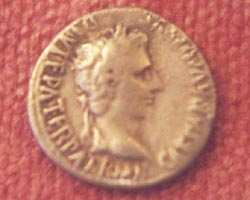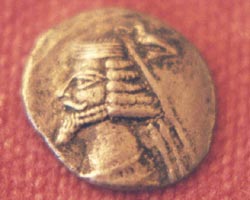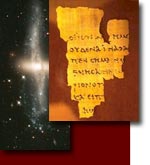| Site Map | Contacts | Links | Newsletter | |
Genesis 1:14-19 DAY 4
Star of Bethlehem
 Coin with bust of Caesar Augustus |
 Coin from time and place of the Wisemen (Mesopotamia) |
What was the star that guided the Magi (wisemen) to Bethlehem? Many people today dismiss this story as a legend; yet sometimes even an ancient story is based on some reality, to explain some event. The city of Troy in Homer’s Iliad was thought to be a myth until Schliemann proved it otherwise. There must have been some astrological event that led the Magi to journey to Jerusalem in search of a king. Edwin Yamauchi has concluded there must be some historical bases for this story (Vardaman and Yamauchi, 1989, 39).
Our western culture is a major barrier to understanding this story. The word "star" (aster in the Greek) is a general word that can include meteors, comets, and planets (any luminous body; L&S 1982, 109). The Magi said they saw his star "in the east" (Matthew 2:2). This phrase en tei anatolei, "in the east" can be translated "in its arising" (Ibid. 59: Robertson 1930, Vol.1, 16). According to Babylonian astronomers there were five cyclically returning phases of the planets that were calculated years in advance (Vardaman and Yamauchi, 43). Three of these special phases are mentioned in Matthew’s text; the first appearance (verse 7), its arising (verse 2), it stopped (verse 9). To Babylonian astronomers there were two stationary points in the apparent motion relative to fixed stars that were calculated (Ibid). This points to the possibility that the star was a conjunction of planets. Below is a clay tablet called an "almanac" that has astronomical texts of 7/6 BC.
Babylonian Tablets
There are hundreds of clay tablets from Babylon and Uruk that have astronomical calculations for astrological predictions. Amazingly, four clay tablets have been found with astronomical calculations for 7 BC (Sachs and Walker 1984, 43-55). This must have been a very important year to the Babylonians because more than one tablet was found, and the conjunction of Jupiter and Saturn in Pisces happens once in 854 years. So this well known conjunction of Jupiter and Saturn on September 15, 7 BC which reached its stationary point two months later on November 12-13 maybe the star of Bethlehem.
Interpreting the Signs
How would the ancient world interpret the conjunction of Jupiter and Saturn in Pisces? In Babylonian astrology the zodiac was related to the countries in the fertile crescent from Mesopotamia to Egypt with the middle of the constellation being important to Palestine (Vardaman and Yamauchi, 45). The second stationary points of Jupiter and Saturn were in the middle of Pisces in 7 BC. Some think that the planet Saturn was associated with the Jews from Amos 5:26, Acts 7:43, and Damascus Document 7:14-15 (Ibid, 44-45). Ptolemy wrote a book called Tetrabiblos that explains astrological signs (Ptolemy 1940). Jupiter is said to be the sign of the birth of a king. In the Treatise of Shem the last zodiac sign of Pisces says, "Then at the end of the year there will be peace and prosperity among all men" (Charlesworth 1983, Vol.1, 486).
Jewish Texts
The Jews at Qumran were expecting a star based upon Baalam’s prophecy in Numbers 24:17, "there shall come a star out of Jacob." The star was the interpreter of the law which was to come" (CD 7.18-20, 1Q 11.6, 1QS 5:27, 4Q Test 12-13). Philo calls Baalam a magus (Philo Moses 1.50.276, cf. 1.16). In the Testament of Levi it says, "his star shall rise in heaven like a king" (Charlesworth, 794). In Rabbinical literature a star stood in the East which swallowed up four other stars at the moment of Abraham’s birth (Strauss, Vol.2, 71). So the Jews were looking for a heavenly sign to foretell the birth of the Messiah.
Ugaritic Text
In the ancient city of Ugarit one clay tablet contains an episode from the Baal cycle about the Holy and Blessed One helping Asherah on a donkey by leading the way with a torch. This is described "like a star in front" (UT 51:IV:17, kkbkb lpnm see glossary #495; For English translation see Coogan, 99).
Latin Texts
Virgil tells how Aeneas was led by a star to where Rome was founded (Virgil Aeneid 2:694). When Caesar Augustus began to reign, a comet appeared for seven days at the games. He interpreted the comet as containing his own birth within it and that it gave consolation to the world (Pliny Natural History II.XXIII.94). On the night Alexander the Great was born, the Magi foretold that a destroyer of Asia was born from a certain constellation (Cicero De Divinatione, I.47). Magi also made visits to other kings as Tiridates did to Nero (Pliny Natural History XXX.I.16-17; Cf. Suetonius Nero 13, Dio Cassius 63.1-7).
Taxes
In Luke 2:1 it says, "there went out a decree from Caesar Augustus that all the world should be taxed." In Ankara an ancient inscription was unearthed that lists the years in which orders for tax collection were issued. The taxation in 8 BC is probably the one mentioned by Luke. Since travel was much slower back then it probably took a year to actually collect the taxes (Hughes 1976, 514). This would put Christ’s birth around 7 BC.
 There
is an interesting new book entitled The
Star of Bethlehem: The Legacy of the Magi by Michael R. Molnar (1999).
Molnar gives some important background information. He believes that the
arising of Jupiter in Aries in 6 BC is the star of Bethlehem based on coins
from Antioch (see Molnar, M. R. "The Coins of Antioch, " Sky
& Telescope, vol. 83, no. 1, pp. 37-39, Jan. 1992).
There
is an interesting new book entitled The
Star of Bethlehem: The Legacy of the Magi by Michael R. Molnar (1999).
Molnar gives some important background information. He believes that the
arising of Jupiter in Aries in 6 BC is the star of Bethlehem based on coins
from Antioch (see Molnar, M. R. "The Coins of Antioch, " Sky
& Telescope, vol. 83, no. 1, pp. 37-39, Jan. 1992).
Another new book is The Star of Bethlehem: An Astronomer's View by Mark Kidger (1999). Kidger believes there were several signs with the triple conjunction of Jupiter and Saturn in 7 BC, and then a nova appeared in March/April 5 BC. Dr. Percy Seymour states, "The nova hypothesis ignores the world view of antiquity. In ancient times the sphere of the stars was considered to be the region of perfection, and according to this world view, stars did not very their brightnesses, and so novae could not exist. Consequently, there are hardly any recordings of novae in the west...It was only in 1572, with Tycho Brahe's discovery of a supernova, that this Aristotelian world-view was finally shattered."
Ernest Martin has written The Star that Astonished the World. He believes the star of Bethlehem was a conjunction of Jupiter and Venus in 2 BC. In order to do this Martin has to change the standard history books about when Herod the Great died. Scholars say Herod died in 4 BC, but Martin has to moved his death back to 2 BC.
Next - Number of Stars
Bibliography
